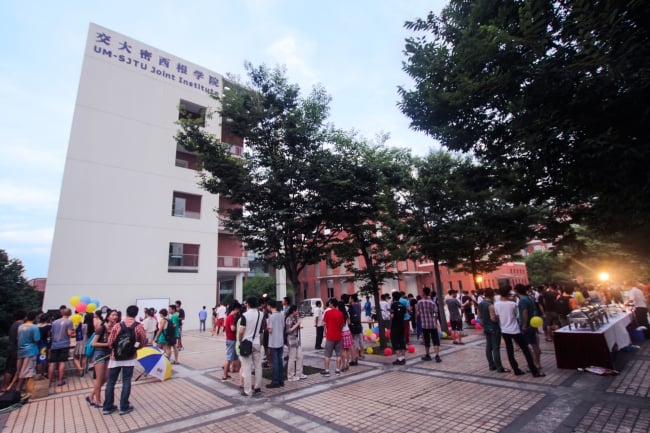You have /5 articles left.
Sign up for a free account or log in.

Students at the University of Michigan Shanghai Jiao Tong University Joint Institute celebrate "American Culture Night."
University of Michigan.
The University of Michigan-Shanghai Jiao Tong University Joint Institute is an English-medium engineering college within SJTU, guided by a board of directors made up of top leaders from both institutions. The institute, which opened in 2006, offers undergraduate and graduate degrees in mechanical and electrical and computer engineering, and its curriculum is adapted from Michigan’s. The degrees are SJTU's, though through a dual degree track undergraduates have the option of applying to Michigan as transfer students to earn a second degree in a different discipline, typically a second engineering discipline.
“To make a long-lasting partnership, it’s critical that both sides understand their own goals and articulate them to the partners,” said James Paul Holloway, Michigan’s vice provost for global and engaged education. “It’s not critical that they be the same; it is critical that they be consistent."
More in This Package
- Numerous universities are bucking the branch campus trend, at least for now. Read more.
- Columbia's creates network of eight "Global Centers" to promote transnational teaching and research. Read more.
"For SJTU, one of the reasons they were interested in the Joint Institute is Chinese higher education as a whole is very interested in reforming itself, in thinking about new ways of doing things, so having a curriculum and a whole school within SJTU which is working in a very different model of higher education, much more of a U.S. style of engineering education, that gave them a chance to observe up close what does that mean, how does it work in a Chinese context," Holloway said.
For Michigan, on the other hand, the university wanted a place to send its engineering students for study abroad and to attract top students from China.
Nearly 300 Michigan students have studied at the joint institute since its founding. “Having a place where they [the College of Engineering] can send a lot of students, knowing that the curriculum they were taking was well aligned with the curriculum here in Michigan, was an attractive model,” said Holloway.
At the same time, more than 500 Chinese students have enrolled in the Joint Institute's dual degree option and transferred to Michigan for two years of their undergraduate careers. Furthermore, the Joint Institute’s graduate school placement statistics show that in 2012 and 2013 more than 80 percent of the Joint Institute graduates were admitted to American graduate schools, with Michigan being the largest beneficiary by far. All told, 303 of the Joint Institute’s 2010-13 graduates were admitted to Michigan's master's or Ph.D. programs.
“To be able to create this group of students who we know really well" has been a big benefit, Holloway said. "A number of these students came and studied here as undergraduates. Even the ones that didn't, we know the curriculum they’ve gone through in a really good way. We know they've been educated in English."
Jun Ni, the founding dean of the Joint Institute and a professor of mechanical engineering at Michigan, said he initiated the partnership about 15 years ago as a simple research collaboration (he is an alumnus of Shanghai Jiao Tong). From there it evolved: “I thought maybe we could start some kind of partnership between the two universities to help them with curriculum development, so we started a pilot program in 2000, then after a five-year trial both universities recognized a benefit and we formed the institute in 2006,” he recalled. The current 10-year agreement between the two institutions extends through 2022.
“That shows a commitment from both universities to further develop and strengthen the partnership,” said Ni, who explained that they’d like to eventually expand beyond engineering to include other disciplines. “Another area for the partnership to deepen is the research collaboration.”
Ni noted that one downside of a partnership approach, as opposed to the branch campus model, is that although there is a jointly controlled board of directors, major decisions ultimately have to be approved by the SJTU administration, since the joint institute is legally part of Shanghai Jiao Tong. Keeping the institute a part of SJTU was an intentional decision. As Holloway said, it’s been an option at points to make it a freestanding entity, but in the end “it makes more sense for us to use the JI as a platform to build the relationship between these two major institutions, between the University of Michigan and Shanghai Jiao Tong University." Yet as Ni pointed out, in the case of the joint institute, “our name is on the logo, but we have limited control. We do have some influence, but it's not like the NYU campus [in Shanghai], where really it’s run by NYU faculty.”
“What I really see is that every school and college creates what fits their needs and their culture,” Holloway said. “Different universities have different missions, different internal structures, so they create what works for them. You have everything from NYU that creates very substantial global portals: they’re trying to really position themselves in a way no one else does as a distributed campus internationally. Other schools stick to very simple exchange programs. I think every school and college has to figure out what fits. What’s useful is to look at models.”




